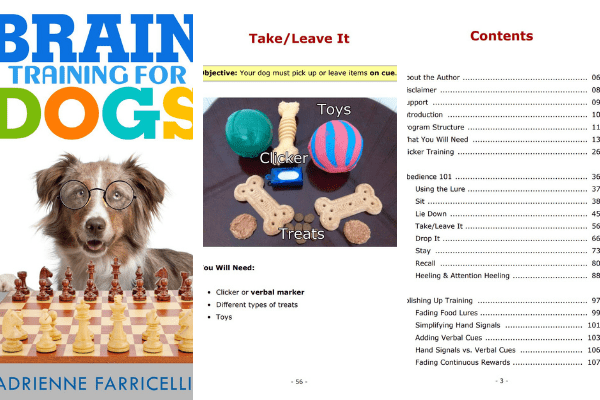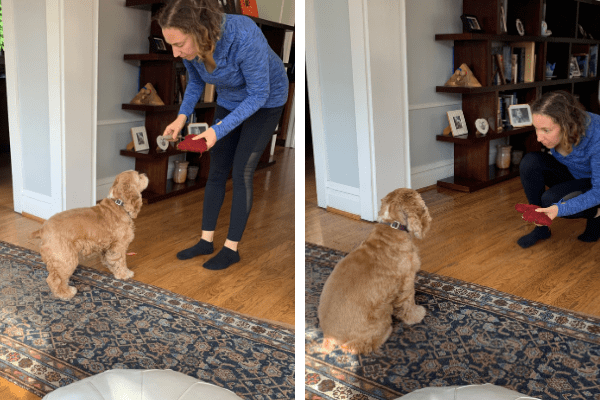Dogs are a man’s best friend – but they’re also food-grabbing, treat-hoarding, mess-making animals.
We love them anyway, yet it’s so much easier and more pleasant when the dog is house trained, can do tricks and will respond to simple demands such as “leave it,” “stay,” and “heel.”
Turns out, it’s not the dog’s fault if his behavior is not up to par: it’s ours.
A 2018 study found that a dog’s behavioral problems are a major source of premature death and other issues for the animal – and there’s a positive link between the owner’s use of aversive or forced training and the severity of their dog’s problems.
The study also found that human contributions to the dog-human relationship have a huge impact on the dog’s behavior and the welfare of the dog, as well as on the health of the dog and the owner.
Translation: if your dog is misbehaving, it’s likely due to a lack of training. And if this is the case, you, as the owner, will suffer. So will your dog.
No one wants that to happen, and many people aren’t prepared to spend the time or the money to train a dog. I certainly wasn’t at the start.
There’s a simple solution – train your dog.
I became determined not to be one of those people who ignored her dog’s bad habits, and finally, 5 years after snagging the best.dog.ever (except for a few issues), I decided to teach my old dog a few new tricks.
As I wanted to train from home, an online dog training method in my case was perfect, and I chose to go with Brain Training for Dogs.
Here is a summary of what it’s all about, and my overall ratings of the course (for those who want to skip ahead):
- Brain Training for Dogs Rating Summary
- What is Brain Training for Dogs?
- What do the Brain Training for Dogs Reviews Say?
- My Experience with Brain Training for Dogs
- Does Brain Training for Dogs Work?
Brain Training for Dogs Rating Summary
 |
|
| Course Content | ⭐⭐⭐⭐⭐ 5 out of 5 stars The course takes you from the very beginning of training to advanced training games so it’s comprehensive. Each chapter is divided into bitesize sections with step by step guides. |
| Troubleshooting | ⭐⭐⭐ 3 out of 5 stars There is a troubleshooting section included with every activity throughout the course. This could be more thorough or cover more scenarios for what to do when a dog doesn’t listen. In most cases when you persist and are consistent with the activity, your dog should learn the task. |
| External Reviews | ⭐⭐⭐⭐ 4.1 out of 5 stars average rating for the eBook. This was from 47 reviews across 3 independent websites. A number of dog owners found it helpful and easy to follow. |
| Value for Money | ⭐⭐⭐⭐⭐ 5 out of 5 stars It has a lot of content in the 2 pdf eBooks as well as video demonstrations and over 100 bonus articles. So at $47 it’s great value for money, especially when you consider that a private dog trainer could cost $500-$1500 per week. |
| My Overall Rating | ⭐⭐⭐⭐ 4 out of 5 stars I liked the content of the course and how easy it was to follow as it was broken down into steps. |
| Money Back Guarantee | 60 day money back guarantee |
| Special Offers | The online course now costs $47 reduced from $97: Brain Training for Dogs Course |
Why is Brain Training for Dogs so Popular?
Although the book has been around for a while, the course is relatively new. Even so it has become popular with dog owners around the world for a number of reasons.
- Gentle Techniques Used. This course relies upon positive reinforcement rather than ‘dominance techniques’ or training based on force.
- Mentally Stimulates Dogs. It not only trains dogs but helps to engage them mentally. This prevents things like boredom in dogs which can lead to bad behavior over time.
- It’s Taught by Certified Dog Trainer. Adrienne Farricelli is a CPDT-KA certified dog trainer with 10 years’ experience. Other courses sold are led by trainers without certification.
- Owners can Enjoy the Games with their Dogs. After the basics of training have been mastered, a lot of the course centres around games that you can play with your dog. This not only helps to stimulate their minds, but it also means you can enjoy some activities together too.
What Is Brain Training for Dogs?
Brain Training for Dogs is an online course which teaches you how train your dog yourself from your own home. It includes two eBooks, 21 short activities shown as videos and a collection of over 100 articles written by the course instructor, Adrienne Farricelli.
The idea is that you work through the course in the main eBook little by little, completing each stage with your dog.
After your dog has mastered the basics, you can choose which activities to continue on with. You can either continue through the book to learn more advanced dog training ‘games’.
Alternatively if you have specific concerns about your dog’s behavior, such as jumping up or whining, then you can turn to the second eBook ‘Behavior Training for Dogs’. This has detailed training techniques for each of these behavioral habits.
There are accompanying videos as a bonus which give you short, sharp tests to be completing with your dog, as well as other resources.
In summary the course contains:
- Brain Training for Dogs pdf (380 pages) . This serves as your main guide for how to train your dog.
- Behavior Training for Dogs pdf (90 pages). This goes through all the different types of common behavior problems in detail. For example one chapter is whining. It then separates this into different types of whining so that you can find the most similar to your own dog’s behavior. For each type, you get training strategies to help stop the behavior.
- Short ‘Exam’ Videos. At the end of each activity you can test your dog on the skills they have learned. To do this, Adrienne has provided 21 short videos (1 minute or so) of each exercise for you to follow along with. You also have a chart so that you can grade your dog out of 3 tries.
- Further Resources. You also get over 100 full articles from Adrienne’s archive as well as Glossary Printouts and other resources for your training.
Here’s a video of some of the more advanced training exercises, followed by an in-depth look at each component of the course:
Brain Training for Dogs pdf: What’s Inside?
The Brain Training for Dogs pdf is the core content of the course and is the main resource you follow along with.
Although it is long (380 pages), each stage of training is divided into short sections so that you can do them one level at a time.
These sections have activities which are structured with bullet points, lists and photographs so that they are easy to understand and do at home.
For each activity you’re given:
Objective: what the goal of the activity is.
What you will need: the items that you will need (most are everyday objects).
Method: a paragraph about the method.
Einstein’s Tip: quick tips about the particular exercise.
Step by Step Instructions: clear instructions with photos.
Troubleshooting Problems: what to do if your dog isn’t responding.
Extending the Challenge: how you can continue the activity on. .
Once you’ve looked through the exercise you should quickly have an understanding of how to complete it, even with no dog training experience.
The pdf itself is divided into certain main chapters. Here’s a quick rundown of the modules that it offers.
It’s not necessary to progress to the end, but he more advanced training games are there if you want them:
Getting Started
This prepares you for the method that Adrienne uses and how the course will work.
It also gives you a list of what you will need to complete the exercises with your dog so that you can have everything ready.
Obedience 101
If you’re just starting out with training or you have a new puppy, then you’ll probably want to go through some basic obedience exercises first.
These teach your dog how to follow your cues and perform simple actions like sitting or lying down.
Each one does take practise in order for your dog to grasp the concept. Adrienne also has a ‘troubleshooting section’ for each exercise in case you’re having problems.
Polishing Up Training
This refines the training that you did in the earlier chapter.
It includes learning how to fade out food treats, use language for commands, and get your dog to respond to cues more quickly.
Preschool
Here your dog learns a few main skills such as targeting an object, or looking into your eyes.
This is the first module that includes a little exam at the end which you can complete with your dog if you wish to.
The exercises are demonstrated in the accompanying videos and you time how long it takes your dog to respond to the task.
Elementary
Here your dog can start to play games. These usually involve your dog using their senses to complete different tasks, like sniffing out treats.
This section is where things start to get much more fun. At the end of each game there are assessment tables so that you can do a little test of how quickly they did the game.
Here you get the short videos of each activity too.
High School
As they grow up so do the tasks!
Here your dog plays more games in order to learn patience.
This is important because it teaches them to settle themselves down when they’re excited.
Aside from this game this skill can be helpful in a number of situations when you’re out and about with your dog.
College
These are some trickier games for your dog like Hide and Seek and other more advanced tasks.
University
The games keep progressing and getting more advanced here.
They can play things like hot and cold and the fun continues!
Graduation
Here your dog learns some quite advanced motor skills like weaving between objects or cones.
This is more along the lines of what is seen at dog shows so it’s not something everyone will want to complete but the activities are there if you want to do them.
They also learn to differentiate words and associate them with certain objects.
Einstein
This final section has brain training exercises like stacking rings on poles, tidying up balls and other advanced tasks.

Behavior Training for Dogs pdf
The second book, Behavior Training for Dogs, is shorter at 90 pages long.
It aims to cover more specific behavior problems.
The main topics they deal with are:
- Whining
- Digging
- Barking
- Chewing
- Jumping
Each section explains the behavior, outlines different types of the behavior and then gives you ways you can train dogs to avoid the behavior.
As it’s structured like this, you can skip ahead to the particular issues you are dealing with. You can then follow the training exercises that are relevant to you.
Activity Videos
Brain Training for Dogs also offers 21 ‘exam videos’ which last just 1 minute each. Every video corresponds to an activity in the Brain Training for Dogs pdf. In these videos the activity is demonstrated by Adrienne and Einstein.
The idea is that once you have tried the activity a few times with your dog, that you do a little ‘exam’.
You grade your dog over a number of tries depending on how long it takes them to complete the task.
In order to pass each section, your dog generally needs to have got a few ‘C’ grades so it does allow for some ‘off’ tries.
Here is an example of a technique for stopping jumping. It’s not an activity video from the course but she shows the training process here. Watch to the end to see the result:
Who Is Adrienne Farricelli?
Adrienne Farricelli is a certified dog trainer and dog behavior consultant.
She has 2 main certifications in dog training. She is:
- Certified by the Certification Council for Professional Dog Trainers in the US.
- Certified dog trainer under the Italian Association for Dog Trainers and Canine Consultants. This has a 200 hour apprenticeship requirement.
She has contributed and published several books as well as running a dog blog. She believes in force-free training and focusses on positive reinforcement training in her course and videos.
Adrienne lives in Arizona with her husband and 2 Rottweilers.
Who Is This Course For?
This is a great course for owners who want to be part of their dog’s training and who enjoy spending time with them doing activities.
It can help dog owners with:
- puppies or untrained dogs.
- dogs who don’t listen.
- aggressive dogs.
- owners having trouble controlling their dogs.
It should be said that the course is not a quick fix solution. The exercises are all short but they will take a few tries for your dog to understand what it is that you want them to do.
Once they’ve mastered one skill you can move onto the next and just go back to the earlier skills for occasional ‘refreshers’.
The idea is that once you’ve successfully trained your dog, you’ll feel much more in control and confident in handling their behavior.
The activities in the course are mostly ‘games’ so they will hopefully be fun for both of you.
Who Is This Course Not For?
This course is not for people who are very busy or short on time. If you don’t have any free time to train your dog then unfortunately the methods won’t work and you may want to look at hiring a dog trainer instead.
It’s more of a course for those who want to be involved with the training themselves and who will enjoy the process too.
Try the Course at a Reduced Price:
Now $47 reduced from $97 for the online course: Brain Training for Dogs
Brain Training for Dogs Adrienne Farricelli Reviews
Brain Training for dogs scored an average of 4.1 out of 5 stars from 47 reviews across 3 independent websites including Amazon and Good reads.
A number of verified buyers loved that the book was:
- Easy to follow.
- Puppies were able to follow along with it, as their first training course.
- Owners managed to correct annoying behavior in their dogs.
- Dog owners felt more confident in their own skills.
The few negative reviews were unclear as no comments were included. The only constructive feedback was that it could go more in depth as to how training itself works.
However each activity has it’s own very clear set of instructions along with a short troubleshooting section, so I found it easy to follow.
Here are a few examples of reviews and comments from customers:
My Review of Brain Training for Dogs
First, How I Found My Perfect Dog
When I was searching for a dog, my criteria was simple: I wanted a lazy breed so I wouldn’t have to spend an hour a day tossing a ball throughout Chicago winters; I wanted a smallish breed so I could travel with it; and I wanted a breed that was family-friendly.
I settled on a Cocker Spaniel, not because this breed necessarily fit all the criteria, but because I spotted a cute cocker up for adoption on PetFinder.
Was it lazy? Was it smallish? Was it family friendly? All the shelter could tell me was that she was a 21-pound stray. Sold.
My Pup Had Issues
I brought home my approximately 5-7-year-old Cocker Spaniel, who immediately chased my cats out of the house, pooped on my wooden floor and snarled at me if I came even close to her food bowl. But she was adorable and she loved my kids, so I was smitten.
We’ve had her now for 5 years, and Lola doesn’t poop on the floors anymore (much), but she does have a big issue that we struggle with but haven’t even attempted to tackle.
Lola is obsessed with her food, otherwise known as food aggression. She guards her food all day, and if you come near the bowl – or even in the same room as it – she growls.
Get closer than she feels comfortable with, and she’ll jump at you and pretend to bite you (though she’s never actually bitten anyone).
It’s scary, and it momentarily transforms our sweet dog into a fierce beast. Give Lola a treat, and she’ll guard that bone like it’s a national treasure.
Something obviously needed to be done.
Enter Brain Training for Dogs
An online dog training method was perfect for what I wanted, and I settled on Brain Training for Dogs.
The course is created by Adrienne Farricelli, a professional CPDT-KA certified dog trainer, who worked for a decade to perfect her method.
She promises to engage dogs on a mental level, developing their intelligence so that their problem behaviors melt away.
Most programs fail because they don’t address the root cause of the problem behavior. But, according to this program, Farricelli will help with the root cause, and the result will be a dog who doesn’t chew, who doesn’t jump, who doesn’t dig, who isn’t aggressive, who doesn’t bark uncontrollably, who listens . . . the list goes on.
Essentially, she’s promising the perfect dog without the use of force or aggression to train the dog.
It’s a 21-game course that also gives users access to a private forum where they can discuss everything “dog” with other owners.
What I like best about the course, is that after the initial training, you can jump from chapter to chapter/ video to video, depending on your dog’s specific issues.
My dog is old, so I wasn’t looking for anyone to teach her how to do fancy tricks like shaking hands or playing dead.
She’s already house trained (she was house trained when we adopted her), and she is very well behaved. But her big issue has to do with her food insecurities, so I really wanted to focus on this problem.
What was Included with the Course?
With this course you get a lot of bang for your buck.
The motto of Brain Training for Dogs is that your dog shows positive behavior when they’re rewarded. So they associate that good behavior with rewards, and everyone is happy.
There are lessons that are nicely laid out, and you can go from one lesson to the next, as they build upon each skill. Or, you can jump around if you want your dog to learn specific tasks, like how to sit or how to bring you a toy.
Once you reach level seven, your dog will be at the Einstein level, and will be able to do amazing things like play the piano, tidy up and stack rings.
I personally didn’t have high hopes for my pup: I just wanted the bare basics. But it was nice to have this kit in case I need it in the future.
Included are also dog training articles – which was a nice bonus to have.
The course book is lengthy at 328 pages but it’s well laid out, so you truly don’t have to read the entire thing like a novel. You can progress in small steps.
Did the Brain Training for Dogs Course Work for Us?
Each class requests different tools, most of which can be found in the average dog household: dog toys and treats. I pulled out a stash of Lola’s favorite dog treats and toys, which immediately got her attention.
The first trick I attempted was the “drop it” trick. In order to train Lola to drop something, we needed to present her with something that she liked, but didn’t love. So we gave her a toy. She was pleased.
When it was in her mouth, we told her to “drop it,” which she did – since we held out a treat, and she can’t help but grab every treat she sees. Success!
This was just a first step but it was a sign that she could respond to the training, and more importantly, the training from me.
Would I Recommend Brain Training for Dogs?
Brain Training for Dogs offers a lot of material for the price and breaks down the training into easy steps. It works well if you can put the time in with your dog to do the exercises together.
Considering how much training is included, along with activities and video guides, the course is quite inexpensive.
They also have a 60 day money back guarantee so this gives you the peace of mind that you can try it out risk free.
If you’re interested in learning how to train your dog yourself, it’s a great resource to try.
Brain Training has a 60-day Money Back Guarantee:
$47 reduced from $97 for the online course: Brain Training for Dogs
What are the Alternatives to Brain Training for Dogs?
Group Dog Training Classes
A class with other dogs, like those that the big box pet stores offer, is ideal for dogs that need socialization and distraction training.
However, if your dog becomes overstimulated easily, you may want to avoid group classes, as he won’t be able to focus with all the other dogs in the room.
It’s also more expensive than Brain Training for Dogs as it’s $30-$80 for a single class. You would have to do a lot of them for your dog to be trained properly.
Private Dog Trainers
Private trainers will work on most issues, but they tend to be a little more expensive than group classes. Dog trainers can charge around $50 for a 1-hour session or $500-$1200 for a 1 week bootcamp.
You may not be in an area where private trainers are readily available, as well (or they’ll charge a ton for the travel fee).
Before you hire a private trainer, ask about their certification (this guide from The Association of Professional Dog Trainers is very informative about the various types of trainer certifications).
Put Together Your Own Training Guide
You can put together your own training routine from resources online. This can work but it would involve a lot more time to find and sequence the training activities.
Does Brain Training for Dogs Work?
As the reviews online say, Brain Training for Dogs has worked for a number of owners experiencing different problems. From training first time puppies to stopping annoying behavior, it has helped with a range of issues. Once they’re worked out it can create a more harmonious home for dog and dog owner.
If you’re experiencing serious issues like extreme aggression or psychological problems in your dog, you may want to see a specialist rather than rely on a training resource.
This course is more for owners facing common behavioral problems as it offers training techniques for dealing with a wide range of these.
What I loved most about the course was how it empowers the owners. They feel much more confident in their own abilities to control their dog’s behavior. Whereas if they had sent them to a dog training centre they could still feel unsure of themselves and how to handle bad behavior.
I also like how it focusses on mental challenges for dogs. This keeps their minds stimulated as well as teaching them to follow commands.
If you feel this course is the right fit for you too, I hope that it brings you a calmer, happier life with your dog.
Try Brain Training for Dogs at a Reduced Price:
Now $47 reduced from $97 for the online course: Brain Training for Dogs






